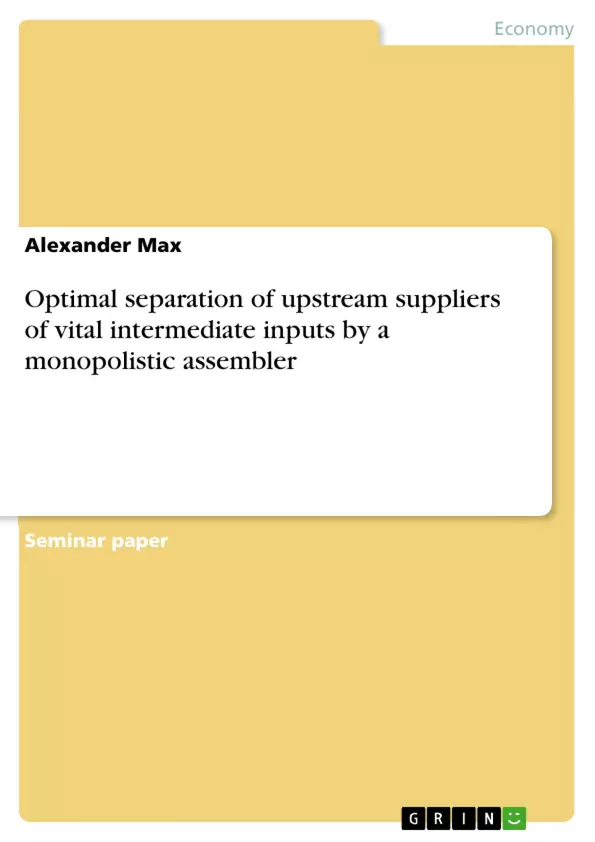In our industrialized world we are confronted with very complex goods. Most of them
became part of our everyday life like cars, planes and so on. These products consist
of several components with high technological requirements to guarantee the quality
of the final product.
For example, the production of a high developed plane, as the Airbus A380, needs
many special single components like turbines, wings, etc. These vital intermediate
goods could either be purchased by foreign firms or be produced by the downstream
assembler itself, respectively by an owned subunit.
A view on the vertical structure among different downstream firms of different products shows that the share in purchased goods from foreign upstream firms varies widely.
Since the components are very specifc, the number of upstream firms which produce
one vital intermediate input is of course limited. In turn, the specific component
could be purchased by less, mostly just one, consumer. A turbine manufactured for
the A380, for instance, could not be used by another assembler than Airbus.
A downstream firm is faced by deciding whether it should either integrate upstream
units and become the owner of them or to sell some upstream firms, respectively let them stay independent, with respect to maximize its own profit.
To provide an answer to the optimal behavior of an assembler, with respect to in-
tegrate or to separate upstream units, I will use a model where the downstream
firm is a monopolist in the final good market and needs a fixed number of vital intermediate inputs in fixed proportions to produce the final product. This model is relatively new and not being discussed by many authors. It was first examined in 2008 by Laussel.
We will see that there exist two effects that influence the decision of the downstream firm. If the independent upstream suppliers have some positive bargaining power, they will sell their produced goods to a price above their costs. That causes the double marginalization effect, because the upstream firms do not account for the effect of its mark-up on the downstream firm. Furthermore an independent supplier, with a positive bargaining power, has a decreasing effect on the prices of the components supplied by the other independent upstream firms, because of the perfect complementary character of the intermediate goods. A high number of independent suppliers yields to relatively low input prices of the particular upstream firms.
Inhaltsverzeichnis (Table of Contents)
- Introduction
- The Model
- Assumptions
- Profits
- Effects
- Laussel (2008)
- Exogenous partial backward integration.
- Endogenous backward integration
- Matsushima and Mizuno (2009)
- Separation under full bargaining power
- Separation under variable bargaining power
- Separation with multiple periods
- Laussel and Van Long (2011)
- Separation when the downstream firm can commit.
- Markov-perfect equilibrium.
- Conclusion
Zielsetzung und Themenschwerpunkte (Objectives and Key Themes)
This paper aims to analyze the optimal behavior of a monopolistic downstream assembler regarding the separation or integration of its upstream suppliers, who provide vital intermediate inputs for the production of the final good. The model considers a situation where the downstream firm faces a fixed number of upstream suppliers with varying degrees of independence and bargaining power. Key themes explored in the paper include:- The impact of independent upstream suppliers on the downstream firm's profits.
- The role of bargaining power in determining optimal separation strategies.
- The effect of double marginalization and competition among upstream suppliers.
- The influence of time consistency and market expectations on the optimal separation policy.
- The strategic implications of backward integration and its limitations.
Zusammenfassung der Kapitel (Chapter Summaries)
Introduction
The introduction outlines the context and relevance of the research, focusing on the complex nature of modern industrial products requiring specialized components. It highlights the importance of upstream suppliers and their role in the vertical structure of industries. The paper introduces the concept of double marginalization and the effect of competition among upstream suppliers on the downstream firm's profit.The Model
This chapter presents the model framework used to analyze the optimal behavior of the monopolistic assembler. Key assumptions are outlined, including the assembler's production function, demand function, and the bargaining power of independent upstream suppliers. It introduces the profit functions for both the downstream assembler and the independent suppliers.Laussel (2008)
This chapter summarizes the findings of Laussel's 2008 paper on backward integration. It examines the effects of exogenous and endogenous mergers on the downstream firm's profitability. The chapter highlights the fact that integrating upstream suppliers is not always profitable, due to the counterbalancing effect of reduced competition among the remaining independent firms.Matsushima and Mizuno (2009)
This chapter focuses on the optimal degree of separation for the assembler, analyzing a static view of the issue. It explores the influence of bargaining power on the assembler's incentives to separate upstream units. The chapter also investigates the impact of multiple periods and price expectations on the optimal separation strategy.Laussel and Van Long (2011)
This chapter discusses the work of Laussel and Van Long (2011) on time consistency and market expectations in the context of upstream separation. It analyzes the effects of binding commitment and the development of a Markov-perfect equilibrium. The chapter shows how these factors can influence the timing and extent of optimal separation.Schlüsselwörter (Keywords)
This paper focuses on the strategic implications of vertical structure in industrial production. Key concepts include:- Monopolistic Assembler
- Upstream Suppliers
- Intermediate Inputs
- Backward Integration
- Bargaining Power
- Double Marginalization
- Competition
- Time Consistency
- Market Expectations
- Profit Maximization
- Citar trabajo
- Alexander Max (Autor), 2013, Optimal separation of upstream suppliers of vital intermediate inputs by a monopolistic assembler, Múnich, GRIN Verlag, https://www.grin.com/document/214540



